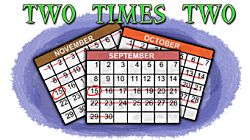Two Times Two
August 17, 2009,by Bob Carson
Editor’s Note: The USTA Web site is pleased to present freelance writer Bob Carson and his popular “Outside the Box” features. This monthly series is a menu of outlandish proposals presented with a wink — but the purpose behind them is serious. The views contained in this column are that of the author alone, and do not necessarily represent the opinions or views of the United States Trotting Association.

Bob Carson
Rambling around in the harness racing field for almost a decade has exposed a conundrum. Not a single person; veterinarian, trainer, driver, adoption agent or blacksmith has ever opined to me that racing 2-year-olds punishing miles is good for horses. So why do we do it?
Money and impatience would seem to be the primary engines behind the practice that most feel is bad for the horses and bad for the racing image. Owners do not wish to wait another year to see if their investment paid off and lucrative paydays for promising 2-year olds are hard to pass up. This leads to ratcheting up the pressure on trainers and horses to “get some money to hold us over” until “the horse matures” and is ready for the 3-year-old season. A season, which due to too much pressure as a 2-year-old, often does not flourish.
In a perfect world, a decree would be passed down in a thunderous voice — “All 2-year-old horse racing will cease.”
In the real world, this will not happen. Money, tradition, self-interests, breeding farms and economics will silence the voice of reason no matter how thunderous.
Change in horse racing, as in most things, is glacially slow and often involves compromise.

Autumn Schmidt graphic
So let’s compromise. Let’s continue to race 2-year-olds, but we will take some of the pressure off the trainers and young horses. The compromise will be a new concept in harness racing: 2-year-old racing will not start until September 15 and will stop on November 15.
Immediately after reading the above sentence, everyone in the harness race game will race to a position after imagining how such a decree will affect his or her business bottom line and their enjoyment of the sport. Before you draw your line in the sand, take a deep breath, look at the big picture, and imagine new possibilities and new parameters for your particular niche.
• The most obvious plus would be that trainers and horses would have precious months to mature; yearlings could be brought along slower.
• With only eight weeks to race, the babies would not need to endure a grueling season.
• The 2-year-olds would still have the chance to strut their stuff and to make some major money.
• If a horse does not make it as a 2-year-old, it would not be devastating. Sure, the owner will not make money, but missing the short season would be easier to bear if the 3-year-old season is just around the corner.
• Trainers and owners would not give up on slower horses as quickly. A few of these may prosper with additional time.
• A short, compact 2-year-old season would be very dramatic with high purses and hard choices of racing venues; the two months could be a new ballgame for excitement and present new marketing opportunities.
• A problem with horse racing is monotony, there is really no beginning or end to the long train. This eight-week 2-year-old season would be an anomaly, something different, with a definite start and stop.
• The eight weeks that the 2-year-olds are on the stage would be a perfect time for the rest of the horses to step out of the limelight and rest. September and October would be a time for overnight horses and trainers to recharge their batteries.
Without a doubt, people will poke holes in this proposal. Poking holes is easy. Pushing green and fragile 2-year-olds where they are not ready to go is hard.
